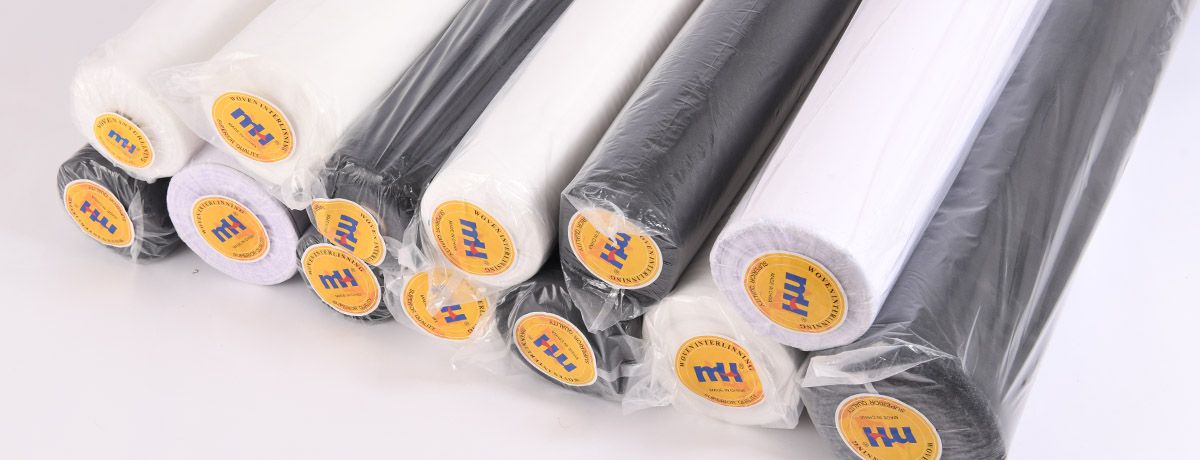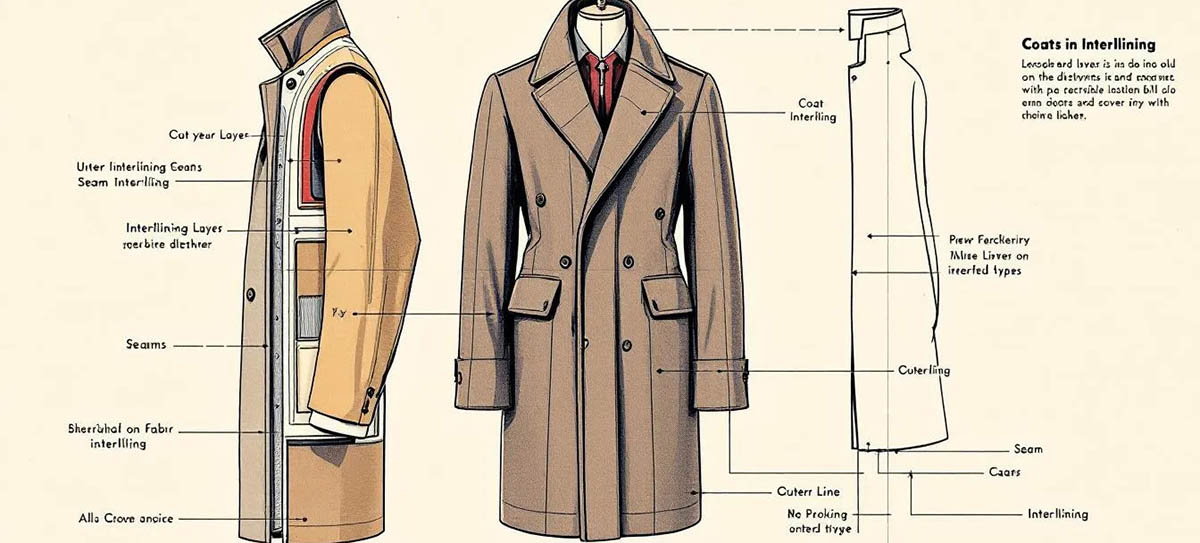Interlining Fabric Essentials: Enhance Your Sewing Projects

Interlining is an extra fabric layer between the main fabric and lining that provides added warmth, structure, and durability. It helps garments like coats and jackets retain their shape and function. This article covers the types of interlining, how to select the right one, and expert tips for application.
Key Takeaways
-
Interlining fabric enhances garments by providing insulation, structure, and bulk, contributing to improved performance and longevity.
-
Two main types of interlining—fusible and sew-in—cater to different fabric requirements and project needs, with specific characteristics determining their application.
-
High-quality interlining ensures garments maintain their shape and appearance, making it a valuable investment for professional and durable clothing.
Understanding Interlining Fabric
Interlining fabric is an additional layer placed behind the main fabric to alter its characteristics, offering benefits such as increased warmth, thickness, and structure. Primarily, it serves to provide insulation and bulk, which is particularly useful in coats and jackets for retaining shape and added warmth.
The materials commonly used for interlining range from natural fibers like cotton and wool to synthetic fibers like polyester. Each material brings its own set of properties, making it suitable for different types of garments and applications. Interlining is typically sewn to the main fabric just inside the seam allowances to minimize bulk and ensure smooth seams.
Knowing how interlining works and its applications can significantly improve the quality of finished garments. Adding interlining helps garments maintain their shape, feel more substantial, and look more polished. This understanding allows for better decision-making, enhancing the overall performance and longevity of your creations.
Types of Interlining Fabrics
Interlining fabrics can be broadly categorized into two types: sew-in and fusible. Fusible interlining adheres to the main fabric with heat, eliminating the need for sewing. This type comes in various weights and thicknesses, making it versatile for different applications. On the other hand, sew-in interfacing is manually attached and is preferred for delicate fabrics that cannot withstand the heat required for fusible options.
There are three main types of interfacing, each with unique characteristics:
-
Woven interfacing: Crafted similarly to woven fabric and requires attention to the grainline during use.
-
Non-woven interfacing: Created by bonding fibers together and lacks a grainline.
-
Knit interfacing: Has some crosswise stretch and is ideal for garments requiring flexibility.
Each type of interlining offers unique benefits, making it essential to choose the right one based on the specific needs of your project.
Choosing the right interlining fabric is key to achieving the desired effect. Whether working with lightweight silk organza, silk charmeuse, or heavier fabrics for tailored garments, knowing the different types of interlining helps you make choices that enhance overall quality and performance.
Selecting the Right Interlining
Selecting interlining depends on several factors, including the texture and weight of the main fabric and the garment’s intended use. Fusible interlining suits smooth fabrics like silk, while rougher fabrics like wool may need sew-in options. The interlining’s weight is another critical factor: fusible for lightweight fabrics, sew-in for heavier materials.
The garment’s purpose is crucial in selecting interlining. Winter coats benefit from insulating interlinings, while shirts may need more flexible options for ease of movement. Testing interlinings on small fabric swatches ensures the desired stability and support before starting a project.
Layering interlinings can also optimize garment performance. Combining different weights of interlining allows for customized support, enhancing the fit and comfort of tailored garments. This approach is particularly useful for adding structure to specific areas like collars, cuffs, and waistbands, ensuring a polished and professional finish.
How to Apply Interlining
Interlining can be applied through sewing or using fusible options that adhere with heat. Begin by cutting each panel from both the main fabric and sew in interlining fabric for a proper fit. Hand-tacking the edges within the seam allowances helps achieve a natural fit and reduces bulk.
Using the correct iron temperature for fusible interfacing ensures a strong bond without damaging the fusible fabric. A pressing cloth can protect against direct heat damage. After fusing or sewing the interlining to the main fabric, treat them as a single piece during construction for easier handling.
Trimming interfacing in the seam allowance helps maintain smooth seams by reducing bulk. Choosing the correct needle type that matches the fabric and interlining weight is also crucial. For heavy fabrics, a walking foot ensures even movement of all layers while sewing.
Combining Interlinings for Enhanced Structure
Sometimes, multiple interlinings are needed to achieve the desired fabric density, drape, and structure. For example, a fine fabric dress may need one interlining for drape, while a jacket requires another for strength. This method is especially useful for constructing stiff corsets or bodices, as well as for enhancing drapery.
Ensure multiple interlinings are compatible in weight and texture to avoid shifting during construction. This compatibility ensures the layers work together harmoniously, adding the necessary structure and stability to the garment. Combine interlinings can greatly improve the performance and appearance of your projects.
Adding structure to garments involves more than using heavier interlining; it also requires strategic placement and layering of different types, including two layers. This approach adds structure by adding stiffness for customized stiffness and shape without compromising comfort and flexibility for the body, making it feel softer.
Common Interlining Applications

Interlining fabrics are used in a wide range of garments and projects. For instance, in coats and jackets, interlining is placed between the outer fabric and the lining to enhance warmth and bulk. Multiple interlinings can improve thermal insulation, making them ideal for colder climates.
In tailored garments, interfacing maintains crisp edges and prevents distortion. Lightweight interlining is preferred in summer garments for structure without bulk. MH’s interlinings are used in collars, cuffs, waistbands, lapels, front plackets, jackets, shirts, uniforms, coats, bags, hats, and home textiles.
Different garments and home textiles require specific interlining types to meet their unique needs. For instance:
-
Shirts
-
Dresses
-
Curtains
-
Trench coats, which often incorporate interlining for added resilience and structure in clothes.
Understanding these applications helps in selecting the right interlining for each project.
Benefits of Using High-Quality Interlining
High-quality interlining ensures garments maintain their shape even after repeated use. It prevents wrinkling and maintains a polished appearance, contributing to the longevity of durable clothing items, including one piece. This quality is especially important for professional and formal wear.
Performance interlinings enhance warmth and provide insulation, adding comfort in colder weather. Interlinings with strong bonding and stable shrinkage enhance garment integrity and shape retention, making high-quality linings a valuable investment for any sewing project.
Choosing superior interlining materials ensures your garments look and feel better, offering a more professional finish. This choice also reduces the need for repairs and replacements, making it cost-effective in the long run.
Expert Tips for Working with Interlining
Achieving professional results with interlining requires attention to detail and expert tips. Always test interlining or interfacing on a small piece of fabric before starting your main project. This step ensures the interlining performs as expected without harming the main fabric.
Matching heavy fabrics with heavier interlining and light fabrics with lighter options is crucial for optimal results. Pre-shrinking interlining materials before washing prevents distortion in finished garments. These practices help maintain the integrity and appearance of your projects, underlining fabrics for better results.
Expert tips include using the right tools and techniques, such as selecting the correct needle type and using a pressing cloth when applying fusible interlining. These small steps can greatly affect the final outcome, ensuring your garments look and feel professionally made.
Wholesale Order
For bulk purchase, MH offers professional wholesale services. Known for reliability, consistent quality, and long-term global partnerships, MH provides factory-direct pricing for wholesalers and apparel manufacturers, making it a cost-effective option to reduce bulk for large-scale customer projects.
MH’s product range includes woven and non-woven interlinings, serving garment factories, textile wholesalers, and tailoring material distributors in over 150 countries. The company uses advanced coating and finishing equipment to ensure consistent quality, offering a complete interlining solution with various coatings and textures.
Buying interlining fabrics in bulk from MH provides access to a wide range of options, including different weights, widths, and colors. This variety allows for a customized approach to each project, ensuring the right interlining is always available to meet specific needs.
Summary
Understanding and using interlining fabrics can significantly enhance the quality and performance of your sewing projects. From selecting the right type of interlining to applying it correctly and combining multiple layers for added structure, each step contributes to a professional finish. High-quality interlining ensures garments maintain their shape, provide warmth, and look polished, making it an essential component in garment construction.
By following expert tips and considering wholesale options, you can make informed decisions that benefit your sewing projects in the long run. Embrace the power of interlining fabrics and elevate your creations to new heights of craftsmanship and durability.
Frequently Asked Questions
What is the primary purpose of interlining fabric?
The primary purpose of interlining fabric is to provide warmth, thickness, and structure to garments, thereby improving their overall appearance and feel.
How do I choose the right interlining for my project?
To choose the right interlining for your project, it is essential to consider the texture and weight of the main fabric, the purpose of the garment, and the desired effect. Testing various interlinings on small fabric swatches will help you achieve the necessary stability and support.
Can I use multiple interlinings in one garment?
Yes, using multiple interlinings can improve the density, drape, and structure of a garment, particularly in designs that require stiffness, such as corsets or bodices.
What are the benefits of using high-quality interlining?
Utilizing high-quality interlining is essential as it enhances garment shape retention, warmth, and overall appearance, while also extending the longevity of clothing items. This investment in interlining significantly improves the quality and durability of your garments.
Where can I purchase interlining fabrics in bulk?
You can purchase interlining fabrics in bulk from MH, which offers professional wholesale services with factory-direct pricing and a variety of options. This ensures consistent quality for your needs.


